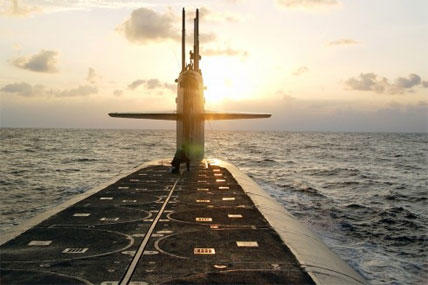National Harbor, Md. -- Navy leaders said Monday the U.S. can't afford to delay the Ohio-class submarine Replacement Program as China and Russia continue to develop new nuclear armed ballistic missile submarines.
"There are two countries on the planet today with a new SSBN in the water and sea based missiles being flight tested. Neither of those countries are the United States – they are China and Russia," Rear Adm. Joseph Tofalo, director of undersea warfare, said at the Sea, Air and Space Exposition here.
"Who would have thought, five years ago, that Russia would not be participating in the G8 summit?" he asked the audience.
The Ohio Replacement Program is now involved in early construction and prototyping as part of a technology development phase. General Dynamics Electric Boat is working on a $1.85 billion five year research and development deal. The contract contains specific incentives for lowering costs and increasing manufacturing efficiency.
The Navy has requested $1.2 billion in research and development funds as part of the fiscal year 2015 budget proposal.
Designed to be 560-feet– long and house 16 Trident II D5 missiles fired from 44-foot-long missile tubes, the Ohio Replacement Program will be engineered as a stealthy, high-tech nuclear deterrent able to quietly patrol the global seas.
Citing Iranian influence in Syria, Chinese activity in the South China Sea, and Russia's annexation of Crimea, Tofalo said that nuclear-armed countries are continuing to impact the geopolitical strategic landscape.
"Would Ukraine have resisted the Russian incursion into Crimea if Russia did not have nuclear weapons? It certainly did impact their thinking," he explained.
Russia and China were also among several countries absent from a recent 35-nation nuclear security summit, Tofalo added.
Tofalo explained how nuclear submarines have helped prevent what he called major-power wars for seven decades by providing a second strike capability for U.S. and Russia should either fire nuclear missiles at the other.
"At present, SSBNs operated by the United States Navy submarine force have over half of our nation's deployed nuclear warheads on them. We have a lot at stake here and have to get this right," Tofalo explained.
He added that the new Start Treaty with Russia, which calls for the reduction of nuclear warheads, will result in a situation where SSNBs will be responsible for 70-perecent of America's deployed nuclear warheads, he added.
Check out our new and improved Military Equipment Guide.
-- Kris Osborn can be reached at kris.osborn@monster.com

























